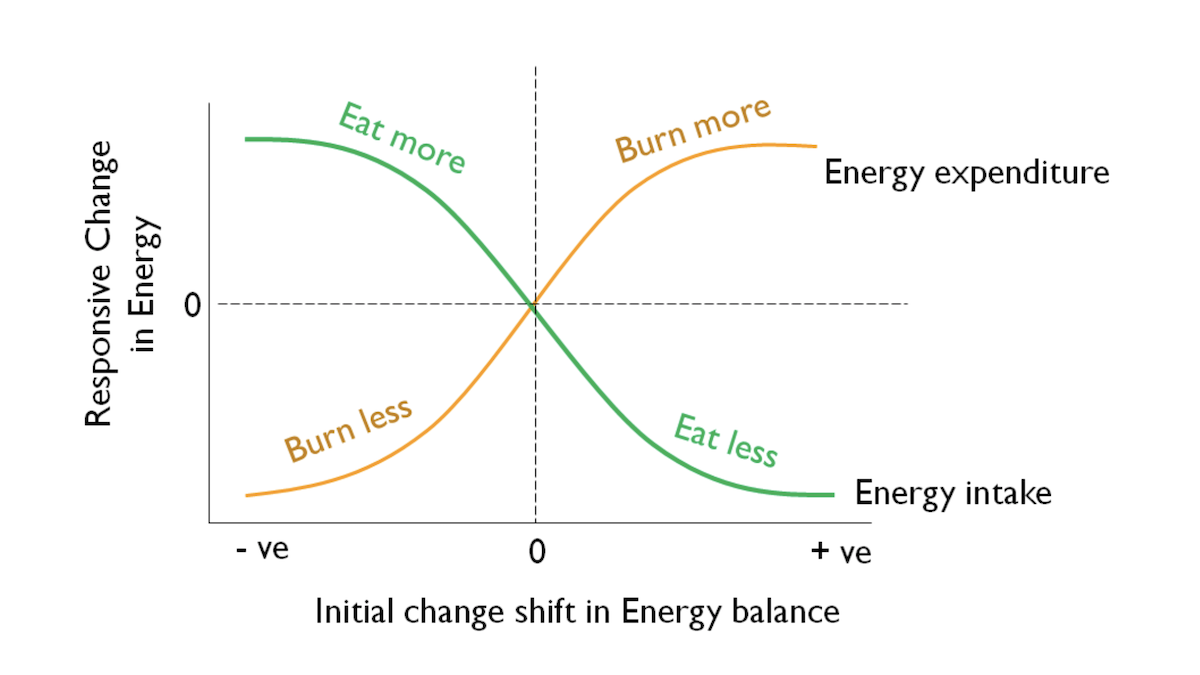The Problem With Thinking About Energy Balance in Calories per Day

Understanding what we mean by calories is all very well but energy balance is often the context that matters to people. In its crudest sense energy balance is nothing more sophisticated than “calories in versus calories out”; or more specifically, the amount of energy we consume over a period of time; versus the energy expended over said period.
Conceptually energy balance is commonly viewed in relation to the first law of thermodynamics, also called conservation of energy, which states that energy cannot be created or destroyed. Ergo, if you consume more energy than you expend this leads to a positive energy balance, resulting in surplus energy being stored and causing you to gain weight. From an interventionist’s perspective, weight loss necessitates a negative energy balance, requiring you to expend more energy than you consume. Indeed, weight loss is often argued indisputably as a fact of fundamental physics.
Yet, to continue this physics argument, one must also recognise that there is also a second and third law of thermodynamics. The third law is not entirely relevant, as it deals with how all molecules stop moving at a temperature of absolute zero. Plus, we can never practically nor experimentally reach this temperature of course.
But the second law is of interest as it does go on to qualify that although energy cannot be created nor destroyed, conversion from one form of energy to another is never 100 percent efficient, and some energy is “lost” as an unusable form of energy during conversion. This describes the concept of entropy, and in most cases, this lost energy is in the form of heat, or thermogenesis.
The relevance of this to energy balance is that this entropy is not a constant. As we have seen already in the last chapter concerning diet-induced thermogenesis, is not just a product of how much you eat, but the food’s composition. Moreover, appreciating the consequential, and sometimes deliberate, variations in thermogenesis is key to understanding energy balance properly, as we shall explore in the second half of this chapter.
Yet, looking beyond physics, energy balance is more than just a concept and needs to be observed in real life, to fully appreciate its relevance. While it is true, shifts in energy balance will inevitably lead to weight change, the fact that under normal circumstances people don’t fluctuate wildly in weight day to day, week to week, even month to month, is evidence alone that energy balance cannot be explainable by mere physics, as we will explore.
Energy Homeostasis
The simple view of energy balance, while describing the comparison of “in versus out”, provides no insight into what has led to the balance. Nevertheless, it is often used to support the notion that both sides of this energy balance equation are voluntarily or behaviourally controlled, such that energy balance can be maintained or changed purely through will-power or conscious control. In this way, changing energy balance for weight loss just requires you to change your behaviour to “eat less, move more”.
Yet, it is important to appreciate how energy balance truly operates in real life, and we can use observations from large-scale longitudinal studies (observing people over long periods) to give us some context. The Framingham Heart Study, for example, has followed participants over several decades to look at health outcomes and includes tracking weight among other things. In a representative population, there is a tendency for people to mainly gain a little bit of weight over the decades during adulthood, and this averages out at a weight change of around 1lb (0.5kg) per year.

Why We Can’t Consciously Control Our Energy Balance
Armed with this observation we can now do some simple maths to calculate what energy imbalance will create this 1lb a year change in weight. Previously we’ve described how fat, protein, and carbohydrate, have a defined energy content, which we can use similarly to estimate the energy content of body tissue. Based on an assumption that body weight is around 75 percent fat, and 25 percent lean tissue (of which 25 percent is protein and the rest is water) the energy content of 1lb of body weight is often assumed to be equivalent to 3500 calories.
Indeed, this 3500 calories rule for weight change is commonly used in clinical practice. If we then express this in energy balance terms, this will be the equivalent of eating an extra hamburger (around 300 calories) every month, which certainly sounds significant. When viewed weekly this translates to an extra biscuit or cookie (around 70 calories) every week.
Yet, when viewed daily, this is the equivalent of an imbalance of only a tiny 10kcal per day or two M&M sweets. What this illustrates is that simply explaining energy balance as something we behaviourally control makes no sense. There is no way, even with the best will in the world, an individual can consciously control their energy balance to within 10kcal per day.
Forget calorie tracker apps on phones, or smart devices measuring calories burnt, it is a total fallacy to assume these can achieve this. Especially given we have already established that measuring energy intake or expenditure has, at best, an accuracy of around 100kcal/day.
Calories Per Day Is Meaningless
What these observations establish is that, in practice, energy balance viewed daily, or even weekly, is relatively meaningless. For most people, daily fluctuations in both energy intake and energy expenditure are such that in reality energy balance can only be revealed when averaging these out over several days or even weeks. The use of Doubly labelled water, which can give us an idea of energy expenditure averaged over many days, is still disputably on the boundary of meaningfulness, especially as for context, energy intake needs to be accurately measured over the same period.
Even in those with very regimented eating and activity, showing true energy balance is incredibly difficult. So, yes, our recommended energy requirements may be expressed as kcal or MJ per day, but it is a misnomer to think this is your daily prescription of calories every day.
But these observations also reveal a more important critique of energy balance. The observation that energy balance is maintained within 10 calories per day, over time, suggests that there must be some level of control over energy balance, beyond just a reliance on our conscious control. This is in no way explained in the simplified view of energy balance.
Conclusion: Energy Homeostasis Rather Than Just Energy Balance
Furthermore, the simple notion of energy balance as an explanation of weight maintenance or weight change, assumes that energy intake and energy expenditure are entirely independent factors, in no way linked to, or influenced by, each other. Therefore, it is more appropriate to think in terms of energy homeostasis, rather than just energy balance.
Homeostasis — the state of steady internal, physical, and chemical conditions maintained by living systems — by definition, operates to maintain a stable equilibrium by monitoring and adjusting. Indeed, our whole physiology and metabolism is essentially collective homeostasis, including, for example, regulation of blood pressure, body temperature, pH or blood glucose.
In energy homeostasis, energy balance is maintained by adjusting both energy intake and/or energy expenditure as necessary. This view of energy homeostasis is best illustrated in a so-called set point theory view of energy balance (see below). In this view, shifts in energy balance lead to responsive drivers of change in both energy expenditure and energy intake to restore the original balance. For example, a shift to a positive energy balance (energy intake greater than expenditure), will drive energy intake down and/or energy expenditure up to offset this shift.

By its operation, energy homeostasis will maintain energy balance and maintain a “set” weight and does fit what we observe in a general population, particularly in the short term. Experimentally we can also support this idea, both in animals and humans. In animals, for example, rodents, after underfeeding or overfeeding, animals tend to adjust their eating and activity when allowed to free eat, and typically restore their original state.
In humans, probably the strongest evidence for this in action is the Minnesota Experiment, published in 1950, whereby conscientious objectors from World War 2 were recruited and experimentally semi starved for six months (eating half the amount of calories they needed). They were then re-fed as much as they liked and all unconsciously overate, until they restored all their lost body protein — a true example of the energy homeostasis view of energy balance in action.
This is an edited excerpt from Dr. Adam Collins’ upcoming book the Metabolic Manual. To read more articles by Dr Adam click here.


















